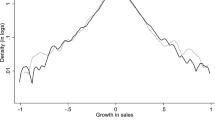Abstract
This paper is set out to examine the temporal pattern of innovative activities: what might have affected a firm’s patenting from one period to the next. Based upon data on ‘information technology’ (IT) manufacturing firms in Taiwan covering the years 1990–2001, we develop a survival model to analyze the underlying drivers of patenting duration. Our results indicate that the level of the patent stock at the onset of the patent spell, defined as the number of successive years during which a firm produced at least one patent per year, has a non-linear effect on spell duration. Other factors, such as industrial growth, firm size and firm profitability, have a positive effect on patenting duration, while firm age and spell sequence affect negatively to spell duration. We conclude that state dependence is demonstrated by innovative behavior, yet the advantages gained from such creative accumulation can easily be dissipated, thereby illustrating the transient nature of dynamic capabilities.


Similar content being viewed by others
Notes
On the nature of technological change and consequent innovative activities, the Austrian economist, Joseph Schumpeter, first envisaged an uneven and random process in which progress was made in short bursts of innovation by new entrants (Mark I); 30 years later, a contrasting (Mark II) Schumpeter model suggested that innovation results from the accumulation of technological competencies, and that such accumulated competencies significantly affect the future technological performance of the firm (for further elaboration, see Malerba et al. 1997).
References
Alfranca, O., Rama, R., & von Tunzelmann, N. (2002). A patent analysis of global food and beverage firms: The persistence of innovation. Agribusiness, 183, 349–368.
Alfranca, O., Rama, R., & von Tunzelmann, N. (2004). Innovation spells in the multinational agri-food sector. Technovation, 24, 599–614.
Aw, B. Y., Chen, X., & Roberts, M. (2001). Firm-level evidence on productivity differentials, turnover and exports in Taiwanese manufacturing. Journal of Development Economics, 66, 51–86.
Cefis, E. (2003). Is there persistence in innovative activities? International Journal of Industrial Organization, 21, 489–515.
Cefis, E., & Orsenigo, L. (2001). The persistence of innovative activities, a cross-countries and cross-sectors comparative analysis. Research Policy, 30, 1139–1158.
Chen, J., Jang, S., Young, J. (2006). The determinants of innovative persistence: An empirical study on patent spells of technology firms. Presented at 48th Annual Conference, Academy of International Business, Beijing, China.
Chiu, Y. C., Lai, H. C., Liaw, Y. C., & Lee, T. Y. (2010). Technological scope: Diversified or specialized. Scientometrics, 82(1), 37–58.
Christensen, C. M., & Bower, J. L. (1996). Customer power, strategic investment, and the failure of leading firms. Strategic Management Journal, 173, 197–218.
Clark, K. B. (1985). The interaction of design hierarchies and market concepts in technological evolution. Research Policy, 14(5), 235–251.
Cohen, W. M., & Levinthal, D. A. (1989). Innovation and learning, the two faces of R&D. The Economic Journal, 99, 569–596.
Collier, W. (2005). Unemployment duration and individual heterogeneity: A regional study. Applied Economics, 37, 133–153.
Fok, R. W., Chang, Y. C., & Lee, W. T. (2004). Bank relationships and their effects on firm performance around the Asian financial crisis: evidence from Taiwan. Financial Management, 33, 89–112.
Geroski, P. A., Reenen, J. V., & Walters, C. F. (1997). How persistently do firms innovate? Research Policy, 26, 33–48.
Gupta, S., Clements, E., Baldacci, E., & Granados, C. (2004). The persistence of fiscal adjustments in developing countries. Applied Economics Letters, 11, 209–212.
Hall, B., Jaffe, A., Trajtenberg, M. (2001). The NBER citations data file, lessons, insights and methodological tools. Working paper no. 8498. Cambridge, MA: National Bureau of Economics Research.
Hansen, J. A. (1992). Innovation, firm size, and firm age. Small Business Economics, 4, 37–44.
Jang, S. L., Tsai, Y. T., & Chen, J. (2008). Persistent innovation: A cross-country study of output and diversity over time. Applied Economics Letters, 15(4), 323–326.
Lee, Y. (2008). Patent licensability and life: A study of U.S. patents registered by South Korean public research institutes. Scientometrics, 75(3), 463–471.
Lee, Y., & Lee, J. (2008). Technology strategy for enhancing the public-to-private technology transfer: Evidence from the duration of patent. Applied Economics, 40, 229–240.
Malerba, F., & Orsenigo, L. (1999). Technological entry, exit and survival, an empirical analysis of patent data. Research Policy, 28, 643–660.
Malerba, F., Orsenigo, L., & Peretto, P. (1997). Persistence of innovative activities, sectoral patterns of innovation and international technological specialization. International Journal of Industrial Organization, 15, 801–826.
Mansfied, E. (1968). Industrial research and technological innovation: An econometric analysis. New York: Norton & Co. Inc.
Martinez-Ros, E. (2000). Explaining the decision to carry out product and process innovation: The Spanish case. Journal of High Technology Management Research, 10(2), 223–242.
Nelson, R., & Winter, S. (1982). An evolutionary theory of economic change. Cambridge, MA: Harvard University Press.
Peters, B. (2009). Persistence of innovation: Stylized facts and panel data evidence. Journal of Technology Transfer, 34(2), 226–243.
Quintana-García, C., & Benavides-Velasco, C. (2008). Innovative competence, exploration and exploitation: The influence of technological diversification. Research Policy, 37(3), 492–507.
Roper, S., & Hewitt-Dundas, N. (2008). Innovation persistence: Survey and case-study evidence. Research Policy, 37, 149–162.
Schumpeter, J. A. (1942). Capitalism, socialism and democracy. New York: Harper.
Yang, C. H., Motohashi, K., & Chen, J. R. (2009). Are new technology-based firms located on science parks really more innovative? Evidence from Taiwan. Research Policy, 38, 77–85.
Ye, F. (2007). A quantitative relationship between per capita GDP and scientometric criteria. Scientometrics, 71(3), 407–413.
Acknowledgment
The authors thank the data assistance provided by Jui-Chung Young and Che-Jung Hsu. Financial support was provided by Taiwan’s National Science Council, Project No. 95-2415-H-002-009 and School of Social Sciences, National Taiwan University.
Author information
Authors and Affiliations
Corresponding author
Rights and permissions
About this article
Cite this article
Jang, SL., Chen, J.H. What determines how long an innovative spell will last?. Scientometrics 86, 65–76 (2011). https://doi.org/10.1007/s11192-010-0247-z
Received:
Published:
Issue Date:
DOI: https://doi.org/10.1007/s11192-010-0247-z




